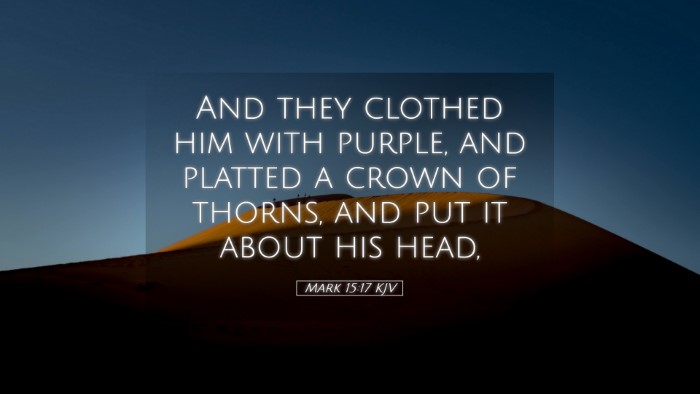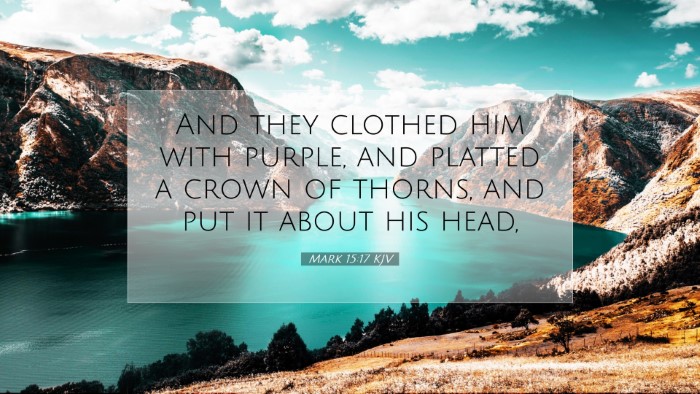Commentary on Mark 15:17
Verse Context: Mark 15:17 states, "And they clothed Him with purple, and platted a crown of thorns, and put it about His head." This moment occurs during the trial of Jesus, where He is mocked and mistreated by Roman soldiers before His crucifixion.
Introduction
This passage serves not only as a historical account but also as a profound theological statement regarding the suffering and humiliation of Christ. The mockery of the soldiers is a pivotal moment that highlights both the reality of Christ’s kingship and the depth of His suffering. Commentators like Matthew Henry, Albert Barnes, and Adam Clarke provide insights that deepen our understanding of this moment.
Matthew Henry's Insights
Matthew Henry reflects on the profound irony present in this scene. The soldiers, while intending to mock Christ, inadvertently reveal the truth of His kingship. He notes that the "purple" robe and the "crown of thorns" serve as symbols of mockery, but they also foreshadow the eventual recognition of Jesus as the King of Kings.
- Royal Costume: The use of purple, a color associated with royalty, is significant. Henry emphasizes that even in mockery, the soldiers lend a semblance of honor to Jesus’ attire, albeit in a twisted manner.
- Crown of Suffering: The crown of thorns, on the other hand, symbolizes the pain and suffering that Jesus would endure. This cruel crown contrasts sharply with the dignity of His true kingship.
- Mockery That Reveals Truth: Henry points out that the soldiers’ laughter and scorn inadvertently reveal the truth: Jesus is indeed a king, although not in the conventional sense they understood.
Albert Barnes' Commentary
Albert Barnes provides a detailed examination of the implications of this act of mockery. He emphasizes the spiritual significance of the soldiers' actions and how they encapsulate the rejection and humiliation faced by Christ.
- Rejection of Christ: Barnes notes that this act represents a broader society's rejection of Jesus. He describes how this moment encapsulates the culmination of the opposition Jesus faced throughout His ministry.
- Fulfillment of Prophecy: Barnes emphasizes that this mocking fulfills Old Testament prophecies regarding the suffering servant, illustrating how Jesus suffered not just for a few but for all humanity.
- Reality of Suffering: The physical act of putting on a crown of thorns signifies the spiritual reality of Jesus’ suffering, which was both physical and emotional. Barnes points to the deeper implications of what Christ’s suffering means for believers today.
Adam Clarke's Elaborations
Adam Clarke expands on the symbols inherent in this moment, highlighting their theological significance. Clarke pays careful attention to the details concerning the crown of thorns and the royal attire presented to Jesus.
- Sins of the World: Clarke interprets the thorns as representative of the sins of humanity, suggesting that they serve as a reminder of the fall and humanity’s suffering as a consequence of sin.
- Jesus as the Suffering King: He notes that while the soldiers intended ridicule, they presented the truth that Christ's reign comes through suffering. Clarke emphasizes that through this act of mockery, they unwittingly proclaim His kingship.
- Symbol of Rebellion: The purple robe is noted as a sign of rebellion against the true authority of God. Clarke argues that the act of dressing Jesus in purple and placing a crown of thorns highlights the extent of rebellion against divine authority.
Theological Implications
The actions recorded in Mark 15:17 invite believers to reflect on several key theological implications:
- Christ's Identity: This moment emphasizes the dual nature of Christ as both suffering servant and sovereign Lord. It challenges believers to reconcile the idea of royalty with suffering, helping them understand the nature of Jesus' mission.
- The Nature of True Leadership: The mockery and humiliation serve as a stark reminder of the world's misunderstanding of power and leadership. As Jesus embraced suffering and service, true leadership in the Kingdom of God often looks different from worldly expectations.
- Suffering and Redemption: The crown of thorns serves as a symbol of hope for believers, reminding them that through Christ's suffering, redemption is offered. It paints a picture of God entering into human suffering to bring restoration and healing.
Conclusion
In Mark 15:17, the interplay of mockery and truth encapsulates the essence of the Gospel. The insights from Matthew Henry, Albert Barnes, and Adam Clarke enrich our understanding of this pivotal moment in Christ’s passion narrative. For pastors, theologians, and students, this passage serves as a profound reminder of the paradox of Christ’s kingship, where glory is found through suffering, and true power is expressed in love and sacrifice.


